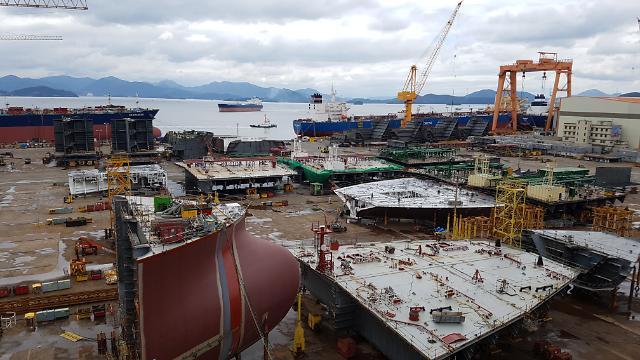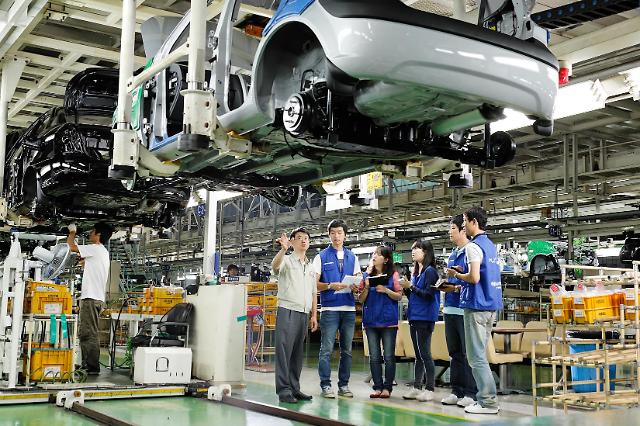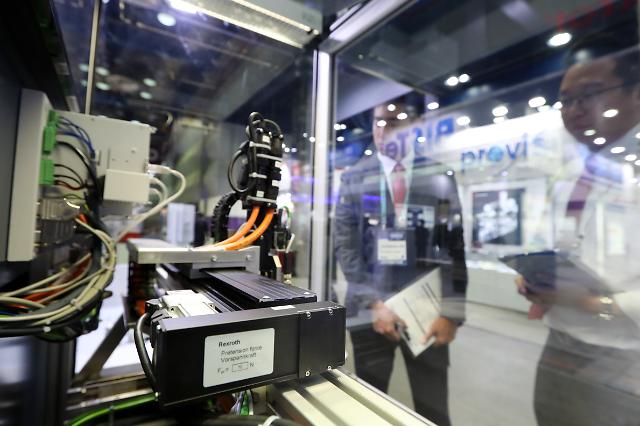
[Yonhap Photo]
South Korea's manufacturing industry, buffeted by negative external factors including tightened US trade protectionism and China's economic retaliation, seems to be losing competitiveness due to internal pressures such as rising wages and corporate tax.
South Korea, which has kept the top position in the global LCD market for nearly 10 years in terms of production, appears to be overtaken by China. Witzview, a market research firm, predicts that this year, China will produce 35.7 percent of the world's large LCD panels to stand first for the first time in history, followed by Taiwan's 29.8 percent and South Korea's 28.8 percent. In particular, China's large LCD panel production capacity is projected to reach 48.3 percent in 2020, nearly half of the global total.
The global market dominance of South Korean TVs and home appliances is also faltering. According to market researcher IHS, Sony stood first with 39 percent in the market for premium TVs worth over $1,500 per unit in the first quarter of this year, followed by LG (35.8%) and Samsung (13.2%). In the first quarter of last year, Samsung accounted for 39.5 percent, followed by LG (17.7%) and Sony (17.5%).
Sony is expected to continue its upward trend in the second quarter of this year. Seoul's Shinhan Financial Investment said Sony's TV sales grew 16.9 percent on-year in the second quarter. In particular, Samsung's second-quarter operating profit fell sharply from a year ago in the consumer electronics division which posted sales of 10.92 trillion won, down 1.0 percent from a year earlier. Operating profit fell 68 percent to 320 billion won.
The situation in the automobile sector is even worse. According to the Korea Automobile Manufacturers Association, annual car production has stayed at 4.5 million units after reaching a record high of 4.65 million in 2011. Last year, production fell to 4.42 million.

[University of Ulsan]
South Korea had been ranked fifth in finished car production for the 11th consecutive year since 2005, but it fell to sixth place behind India last year. Probably, it's not easy for South Korea to keep its current status as Mexico, ranked seventh, is catching up fast. The production gap with Mexico has been narrowed from 900,000 units in 2012 to 170,000 units as of the first half of this year. The drop is attributable mainly to Hyundai and Kia suffering a decline in their competitiveness.
"India and Mexico are steadily absorbing the world market with cheap labor," an auto industry official said. "Meanwhile, Hyundai and Kia are suffering from poor competitiveness due to labor disputes and a THAAD row." In the first half of this year, Hyundai's sales in China fell 40.7 percent on-year and Kia's sales were down 54.2 percent.
The shipbuilding industry, which competes with China to win orders, is in a similar situation. According to Clarkson, a shipbuilding research institute, China stood first in monthly orders in June and July ahead of South Korea. In August, South Korea regained its top position but it only received orders for five ships, compared to 14 in June. The bigger problem is that the industry does not show any sign of improvement.
"Due to unfavorable factors at home and abroad, the competitiveness of domestic manufacturers is weakening day by day," said a shipbuilding industry official. The Hyundai Heavy Industries shipyard in the southwestern port of Kunsan, which once led the regional economy, has been shut down for three months because of the order cliff caused by a global downturn. The market share in LNG carriers, drill ships and large container ships markets dominated by South Korea has been declining.
Tata Daewoo, launched by India's Tata Group, is threatening Hyundai in the commercial vehicle market. Brand Finance, a British brand consulting firm, rated Tata's brand value at $23 billion, reflecting its successful operation.

[Yonhap Photo]
Official data showed that South Korea's average manufacturing utilization rate in the second quarter of this year was 71.6 percent, the lowest level since the first quarter of 2009. Foreign institutions gave a gloomy outlook. Deloitte Global and the US Competitiveness Commission predicted South Korea would fall from the fifth place last year to sixth in 2020 in the International Manufacturing Competitiveness Index.
India, now in the top 10, is expected to occupy the fifth place, while the United States, China, Germany and Japan would still be in the top group by 2020.
Analysts attributed the setback in South Korea's manufacturing sector to a loss of distinction after being sandwiched between technology-dominated and cost-effective manufacturing powerhouses. As productivity remains stagnant and the introduction of new industries is being delayed, South Korea is falling back with its low-efficiency and high-cost structure hurting profitability.
The external environment is also unfavorable. Chinese manufacturers are rapidly running after South Korea with state support. In shipbuilding, China is improving its competitiveness through national financial and front-to-back support, and it is increasing its market share especially in the bulk carrier market which has relatively low technical barriers.
The Trump administration's allegation that the Korea-US free trade agreement (FTA) should be scrapped poses a threat to the Korean manufacturing industry. Experts advise that there should be differentiated technology and active government support to restore South Korea's competitiveness. "We must make efforts to strengthen the cost competitiveness of our manufacturing industry and strengthen our technological competitiveness," said an Export-Import Bank official.
The Korea Institute of Industrial Economics and Trade said it is imperative to improve the internal environment by easing tax credit requirements for research and development.




![[SUMMIT] S. Korea to cooperate with Viet Nam to achieve trade amount of $150 bln by 2030](https://image.ajunews.com/content/image/2023/06/23/20230623161041322216.jpg)